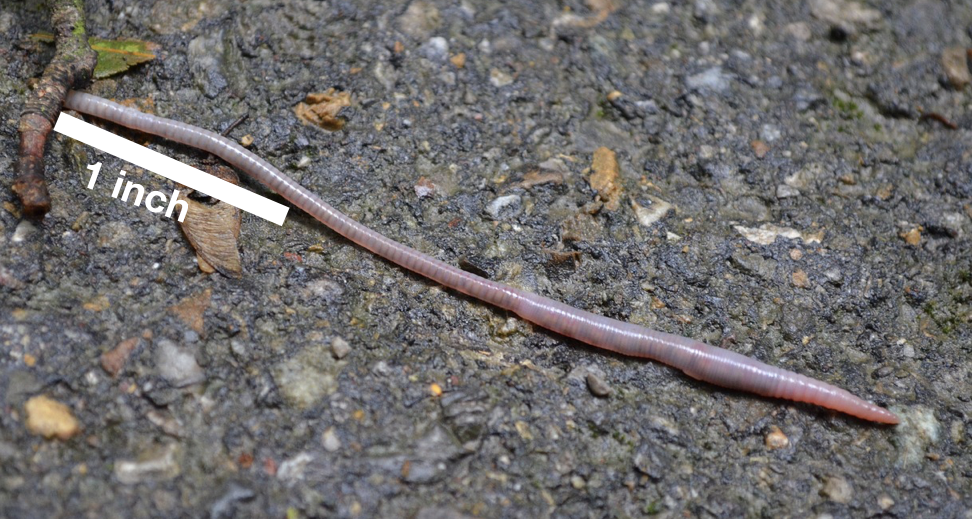Lesson 14
Estimation Exploration
Warm-up: Estimation Exploration: Fractional Measurement (10 minutes)
Narrative
Launch
- Groups of 2
- Display the image.
- “What is an estimate that’s too high? Too low? About right?”
- 1 minute: quiet think time
Activity
- “Discuss your thinking with your partner.”
- 1 minute: partner discussion
- Record responses.
Student Facing
What is the length of this earthworm?

Record an estimate that is:
| too low | about right | too high |
|---|---|---|
| \(\phantom{\hspace{2.5cm} \\ \hspace{2.5cm}}\) | \(\phantom{\hspace{2.5cm} \\ \hspace{2.5cm}}\) | \(\phantom{\hspace{2.5cm} \\ \hspace{2.5cm}}\) |
Student Response
For access, consult one of our IM Certified Partners.
Activity Synthesis
- “What do you know about Estimation Explorations?” (It's not about finding the exact answer. We make an estimate that is too low, too high, and about right. The estimate could be the value of an expression, the number of items in an image, or a measurement.)
- Consider asking: “What would you have to think about if you were going to design an Estimation Exploration like this one?” (There is something in the image that gives a clue about the general length of the object. Choosing an object that is not an exact length in whole inches.)
- Record and display responses for all to see.
Activity 1: Design Your Estimation Exploration (20 minutes)
Narrative
The purpose of this activity is for students to collaborate and create an Estimation Exploration activity that focuses on fractional measurement. Students find an object from the classroom or an image in a book or another source. They anticipate and record what other students might estimate the length of the object to be.
Supports accessibility for: Memory
Required Materials
Materials to Gather
Required Preparation
- Each group of 2-3 needs picture books and a ruler to design their Estimation Exploration activity.
Launch
- Groups of 2–3
- Give each group picture books and a ruler.
- “Work with your group to create an Estimation Exploration activity about measuring objects to the nearest half or fourth of an inch.”
Activity
- 15 minutes: small-group work time
Student Facing
- Find an object or an image that would make an interesting estimation problem. Write a question that would encourage others to answer with a length estimated to the nearest half or fourth of an inch.
-
Think about possible estimates others might make for the length of the object or image.
Record an estimate that is:
too low about right too high \(\phantom{\hspace{2.2cm} \\ \hspace{2.2cm}}\) \(\phantom{\hspace{2.2cm} \\ \hspace{2.2cm}}\) \(\phantom{\hspace{2.2cm} \\ \hspace{2.2cm}}\) - Measure the length of the object or image to make sure your estimates make sense. If needed, revise your estimates.
Student Response
For access, consult one of our IM Certified Partners.
Activity Synthesis
- “What questions do you still have about creating your Estimation Exploration?”
- Give students a few minutes to make adjustments, if needed.
Activity 2: Facilitate Your Estimation Exploration (15 minutes)
Narrative
The purpose of this activity is for students to facilitate the Estimation Exploration they created in the previous activity. Each group takes turns facilitating their Estimation Exploration for another group (or two groups, if time permits).
Advances: Speaking, Representing
Required Materials
Materials to Gather
Required Preparation
- Each group of 2–3 from the previous activity needs 1 piece of chart paper and a marker.
Launch
- Groups of 2–3 from the previous activity
- Give each group a piece of chart paper and a marker to record responses.
- “Now work with another group and take turns facilitating the Estimation Exploration activity you created.”
Activity
- 10–12 minutes: small-group work time
- Remind students to switch roles after 5–6 minutes.
Student Facing
- Display your image for your classmates.
- Ask them, “What is an estimate that’s too high? Too low? About right?”
- Give them a minute of quiet think time.
- Give them a minute to discuss together.
- Ask them to share their estimates.
- Record their ideas.
Student Response
For access, consult one of our IM Certified Partners.
Activity Synthesis
- “What did you learn as you facilitated your Estimation Exploration?” (The estimates might be much higher or lower than expected. It helps to be familiar with what we're trying to estimate.)
Lesson Synthesis
Lesson Synthesis
“What were some important things you considered about the length of the object as you created your Estimation Exploration? Why were they important?” (To make it possible to estimate, we need to show how long 1 inch was compared to the length of the object. The object is not so large or so tiny that it would be hard to estimate to the nearest half or quarter inch, or that it wouldn't make sense to do so.)
Cool-down: Estimation Exploration Reflection (5 minutes)
Cool-Down
For access, consult one of our IM Certified Partners.